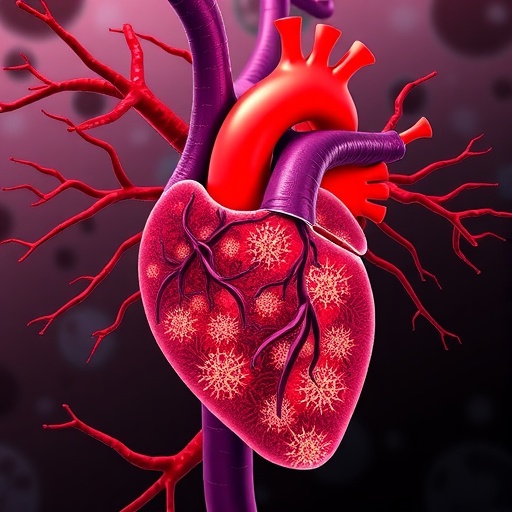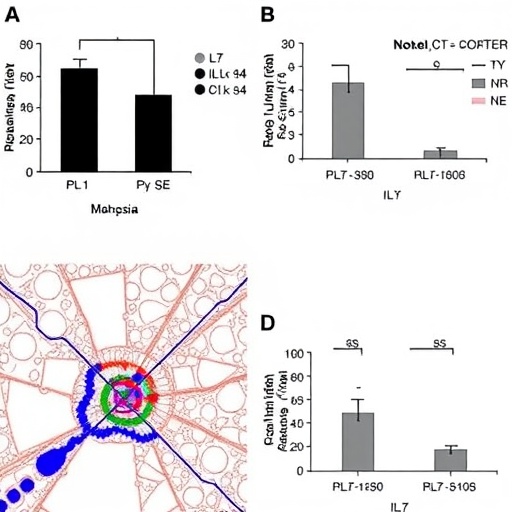
In a groundbreaking study published in the Journal of Translational Medicine, researchers have unveiled a novel therapeutic approach that could significantly mitigate the effects of septic cardiomyopathy, a severe condition characterized by heart dysfunction due to systemic infection. This innovation hinges on the modulation of the integrated stress response, specifically targeting the ATF4-DDIT4/TXNIP pathway, which has been implicated in mitochondrial dysfunction and ferroptosis—the process of regulated cell death associated with iron metabolism and oxidative stress.
Septic cardiomyopathy, a complication commonly associated with sepsis, remains a major challenge in critical care. Patients suffering from this condition often experience significant complications, leading to increased morbidity and mortality. The complexity of sepsis-induced heart failure has left researchers grappling with a plethora of questions regarding its pathophysiology and, more importantly, effective treatment strategies. This latest research provides hope by identifying a pathway that may be crucial in restoring cardiac function during sepsis.
At the heart of the new therapeutic strategy is ISRIB, a small molecule that has demonstrated potential in enhancing the efficacy of the integrated stress response (ISR). The ISR acts as a cellular response network to various stressors, including those induced by inflammation and infection. This study systematically investigates how targeting the ATF4-DDIT4/TXNIP axis can attenuate the detrimental effects of mitochondrial dysfunction in cardiomyocytes, potentially reversing the impacts of septic cardiomyopathy.
Mitochondrial dysfunction has emerged as a central player in the pathogenesis of septic cardiomyopathy. Under normal circumstances, mitochondria generate adenosine triphosphate (ATP) through oxidative phosphorylation, regulating energy supply within the cells. In the setting of sepsis, mitochondrial function deteriorates, leading to reduced ATP production and increased generation of reactive oxygen species (ROS). This dysregulation not only impacts energy metabolism but also initiates a cascade of cellular events culminating in cell death.
The study’s authors designed a series of experiments to elucidate the relationship between the ATF4-DDIT4/TXNIP signaling axis and mitochondrial health. By utilizing both in vitro and in vivo models, they demonstrated that expression of DDIT4, a protein involved in the ISR, significantly correlated with the degree of mitochondrial dysfunction and ferroptosis in cardiac cells exposed to septic conditions. This finding highlights the critical role of this pathway in mediating cellular stress responses in cardiomyocytes.
Additionally, the researchers explored the biochemical pathways leading to ferroptosis, which is characterized by iron-dependent lipid peroxidation. In their findings, the overexpression of TXNIP markedly exacerbated ferroptosis in cardiomyocytes, presenting a key mechanism through which septic conditions could induce cardiac cell death. The inhibition of TXNIP expression appeared to mitigate these effects, presenting a potential therapeutic molecule for preventing lethality in septic cardiomyopathy.
The incorporation of ISRIB into treatment regimens emerged as a highly promising strategy. By enhancing eIF2B activity, ISRIB prevents the translational shutdown induced by the ISR activated during stress, allowing for the preservation of mitochondrial function in cardiomyocytes. Early interventions with ISRIB not only reduced markers of mitochondrial impairment but also improved cardiac output in experimental models of sepsis.
One of the most significant findings of this study is the timing of ISRIB administration. The authors propose that early application of ISRIB could be critical in outmaneuvering the progression of septic cardiomyopathy. Timing in therapeutic interventions is everything in critical care, and understanding when to initiate treatment could pave the way for better survival rates among septic patients.
Moreover, the research emphasizes the necessity of further clinical studies. While the preclinical data are promising, the transition from bench to bedside remains a complex journey. Researchers assert that understanding the translational aspects of ISRIB and its effect on human cardiac tissues will be essential for its eventual application in clinical settings.
The implications of this work extend beyond just septic cardiomyopathy; they offer a glimpse into how harnessing the body’s intrinsic stress responses could lead to breakthroughs in various conditions associated with oxidative stress and cellular dysfunction. By targeting specific pathways, researchers may unveil novel avenues for therapy that can be applied across a spectrum of diseases.
Furthermore, this research underscores the importance of a multidisciplinary approach. By combining fields such as molecular biology, pharmacology, and clinical medicine, the study demonstrates how collaborative efforts can lead to revolutionary findings. As the understanding of cellular stress responses continues to grow, the integration of these findings into clinical practice could revolutionize how critical illnesses are managed.
In conclusion, this study not only highlights the mechanistic insights into septic cardiomyopathy but also sets the stage for potential therapeutic strategies aimed at ameliorating this debilitating condition. As research progresses, the hope is that ISRIB and other similar molecules can be integrated into standard care practices, significantly improving outcomes for patients grappling with the ramifications of sepsis and its systemic effects.
With the ongoing challenges posed by septic cardiomyopathy and its related complications, research such as this serves as a beacon of hope, illuminating paths toward improved health outcomes. The collective effort of the scientific community to translate basic findings into effective treatments is crucial in addressing the urgent needs of critically ill patients worldwide.
In an era where sepsis remains a formidable challenge in healthcare, the emergence of ISRIB as a potential therapeutic agent represents a forward-thinking approach, potentially reshaping the treatment landscape of septic cardiomyopathy. As we move towards a more nuanced understanding of the disease, continuous research efforts and clinical trials will be pivotal in validating these promising results and ensuring progression from laboratory to real-world application.
Subject of Research: Septic Cardiomyopathy and Integrated Stress Response Therapies
Article Title: Targeting ATF4-DDIT4/TXNIP induced mitochondrial dysfunction and ferroptosis: ISRIB as novel therapy for septic cardiomyopathy.
Article References:
Chen, Y., Feng, X., Li, Z. et al. Targeting ATF4-DDIT4/TXNIP induced mitochondrial dysfunction and ferroptosis: ISRIB as novel therapy for septic cardiomyopathy.
J Transl Med 23, 938 (2025). https://doi.org/10.1186/s12967-025-06939-9
Image Credits: AI Generated
DOI: 10.1186/s12967-025-06939-9
Keywords: Septic cardiomyopathy, ISRIB, ATF4, DDIT4, TXNIP, mitochondrial dysfunction, ferroptosis, integrated stress response, sepsis.
Tags: ATF4-DDIT4/TXNIP pathway in sepsisimplications of iron metabolism in cell deathinnovative strategies in critical care medicineintegrated stress response modulationISRIB therapy for septic cardiomyopathymechanisms of sepsis-induced heart failuremitochondrial dysfunction and cardiac healthnovel treatment for septic heart failureoxidative stress and heart diseasepotential of small molecules in cardiac therapyreducing morbidity in septic patientstargeting ferroptosis in heart dysfunction




